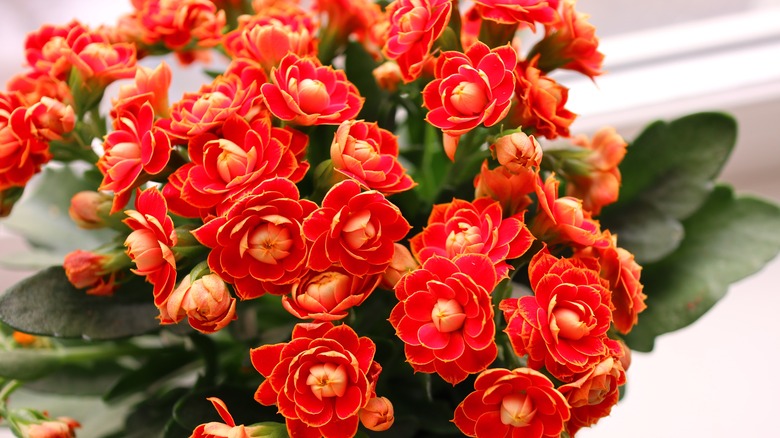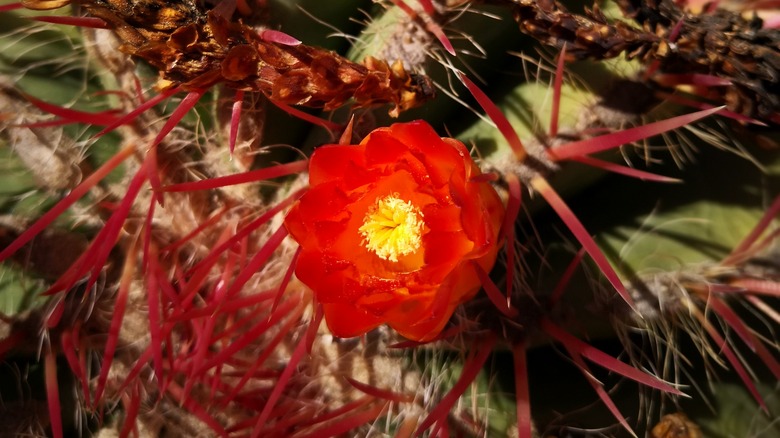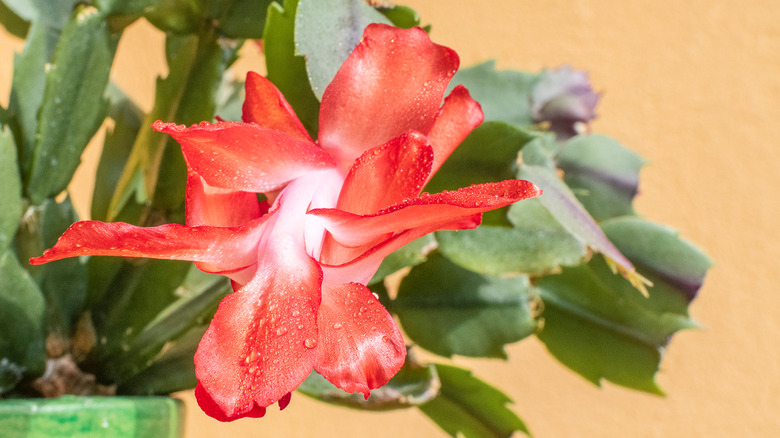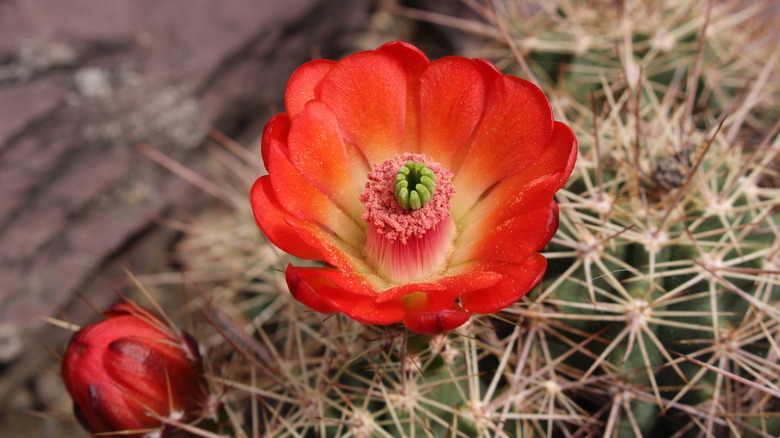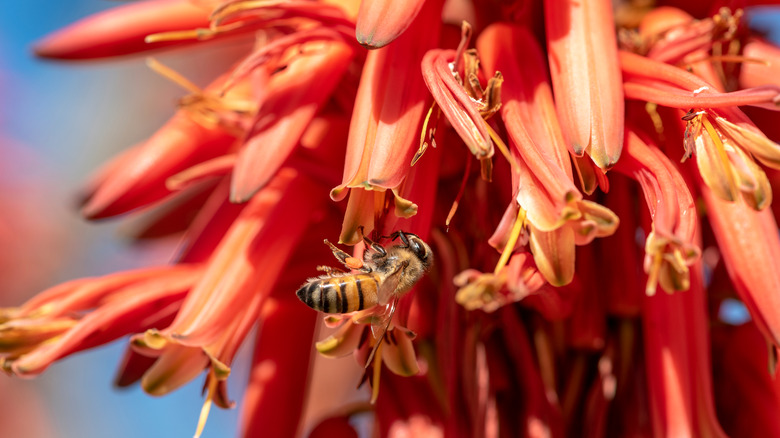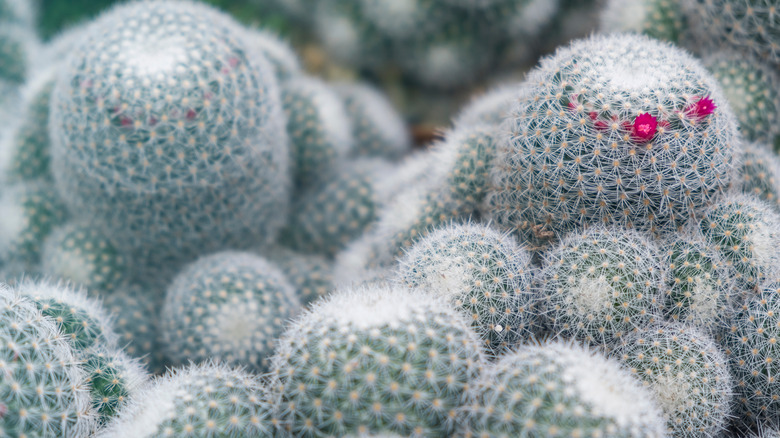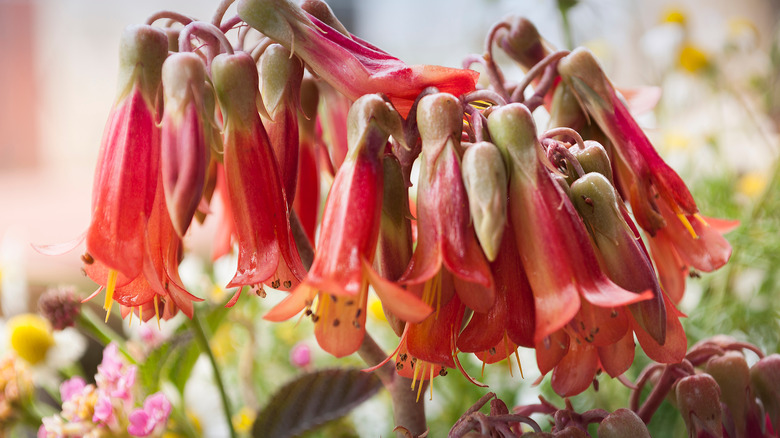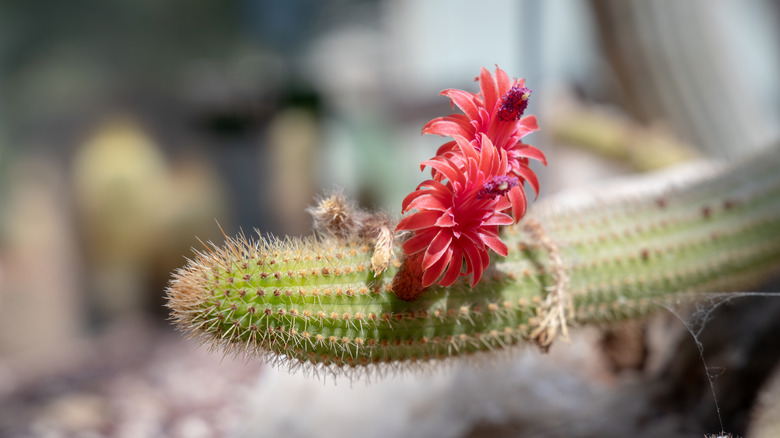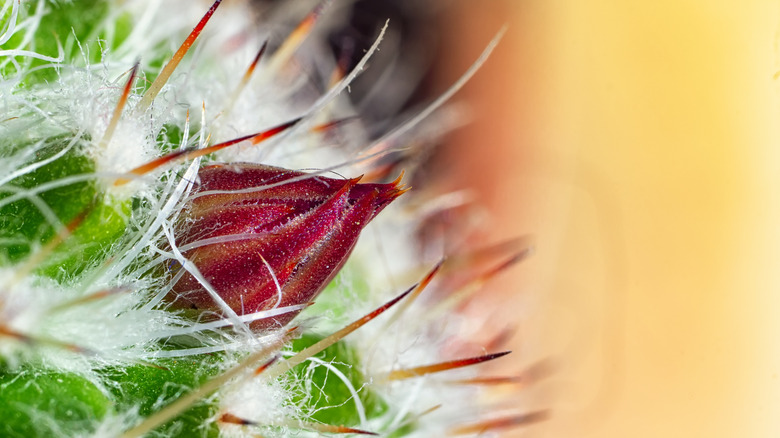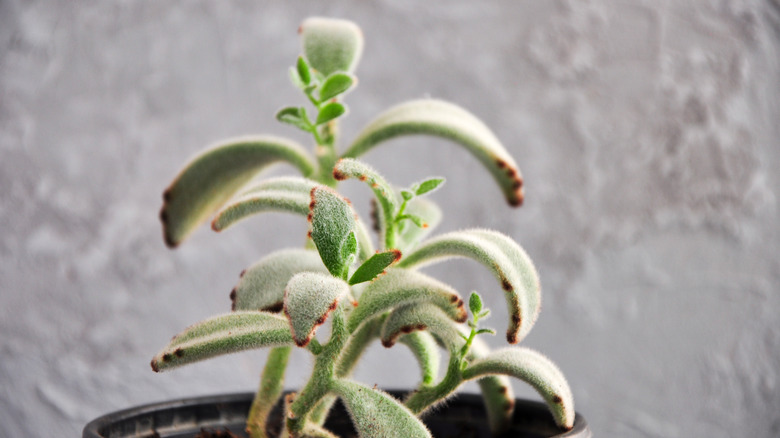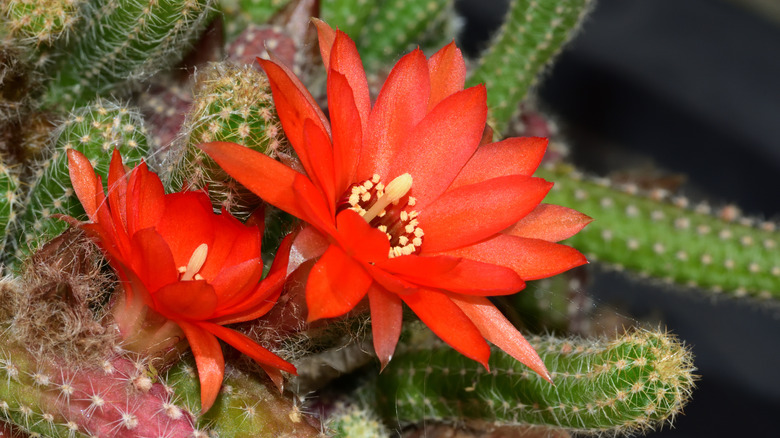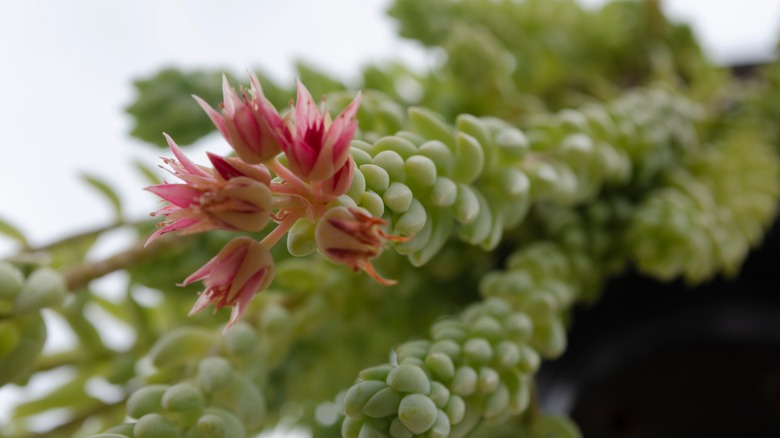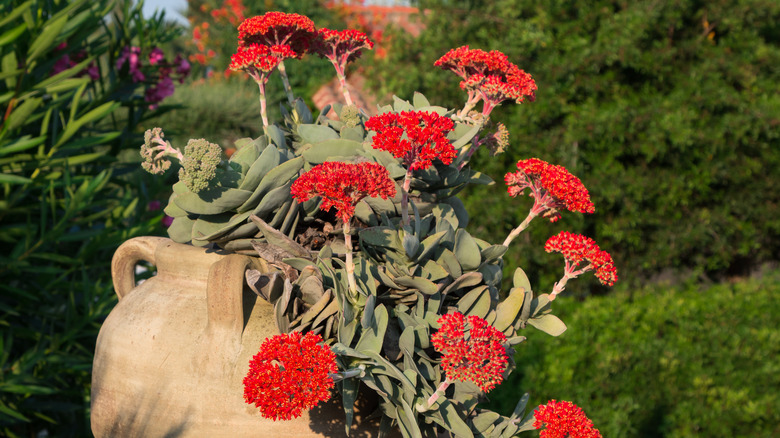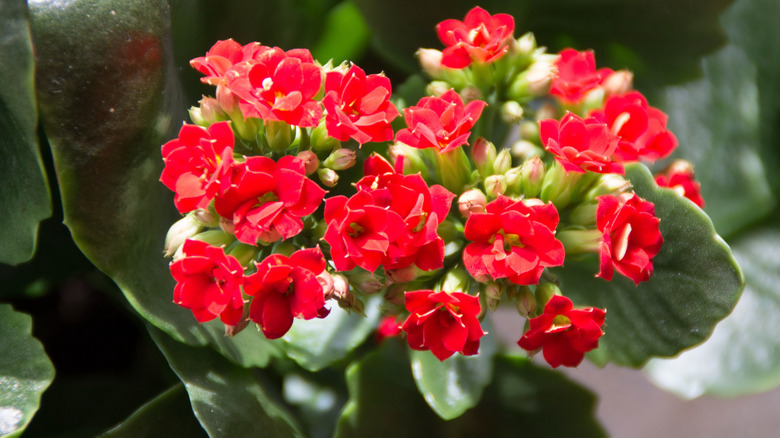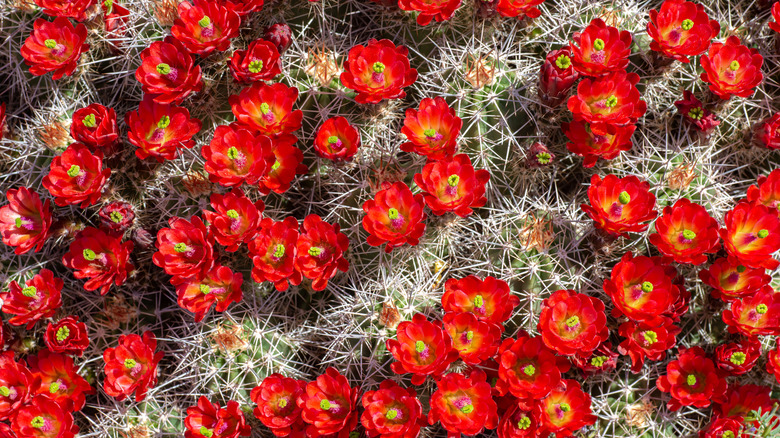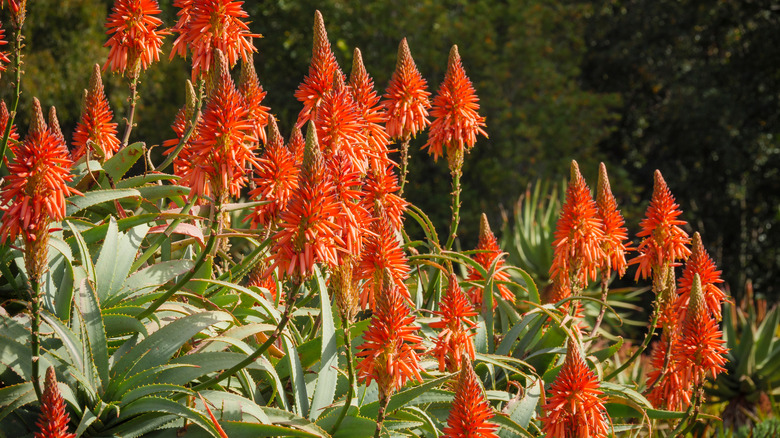15 Succulents That Bloom With Pretty Red Flowers
Succulents, as well as cacti, are all the rage for busy plant owners. In general, these drought-tolerant and sun-loving plants require very little attention. You can place them in a sunny window or plant them in a sun-bathed part of your garden, water them minimally, and watch them thrive. Better yet, many cacti bloom with gorgeous flowers that may be orange, yellow, purple, pink, or red if you like bolder options.
Blossoming red flowers are sure-fire attention-getters. Their bright, intense, and provocative color stands out in the garden against a green sea of foliage and stems. As Longfield Gardens explains, red is a complementary color to green, allowing both hues to look their best when they are placed next to each other. If you don't want to deal with the upkeep of a perennial flower garden, or worse, an annual garden, planting a few different species of blooming cacti into the ground or containers can give you the same fiery visuals with almost none of the painstaking maintenance.
1. Barrel cactus
The barrel cactus (Echinocactus grusonii), which is also referred to as mother-in-law's cushion, is a low-growing yet wide cactus that is covered with orange-red spines on its many ribs. In the summer, it blooms with bell-shaped flowers that attract pollinators, per the University of Vermont. These flowers more frequently appear yellow, but they can be red when you purchase the right variety.
Bloom Season: Summer
USDA Growing Zone: 9 to 12
Growing Conditions: Full sun
Soil Type: Coarse and well-draining
Size: 2 to 3 feet tall
2. Christmas cactus
The blooms of the Christmas cacti (Schlumbergera russelliana) can be many different colors, as per North Carolina State Extension, but most often, they are a shade of red. These plants, which bloom during the holiday season, boast a flower-within-a-flower look which is a rare sight on a cactus. Even when the plant is not in bloom, its unique, flattened stems are quite ornamental on their own.
Bloom Season: Fall and winter
USDA Growing Zone: 9 to 11
Growing Conditions: Full sun
Soil Type: Moist and well-draining
Size: 6 inches to 1 foot tall
3. Scarlet hedgehog cactus
Scarlet hedgehog cacti (Echinocereus coccineus) are a cold-hardy species that are regarded for their large red blooms that erupt out of their stems in the middle of spring. Usually, they only last for a few weeks, but you can enjoy them yearly as this cactus variety is known to live for a long time, as pointed out by High Country Gardens.
Bloom Season: Spring
USDA Growing Zone: 4 to 9
Growing Conditions: Full sun
Soil Type: Well-draining
Size: 5 to 8 inches tall and 12 to 18 inches wide
4. Aloe vera
Aloe (Aloe barbadensis) is well-known for its fleshy leaves filled with healing gel that can be used on minor burns and cuts. However, only some people know that the plant also produces gorgeous red flowers. Because aloe vera is often grown indoors in colder regions, it's rare for people to see it bloom since it must be planted outdoors to do so, as the University of Florida notes.
Bloom Season: Late winter to spring
USDA Growing Zone: 8 to 11
Growing Conditions: Full sun to partial shade
Soil Type: Well-draining
Size: Up to 2 feet tall
5. Old lady cactus
The old lady cactus (Mammillaria hahniana) looks like an old lady's head wearing a crown of flowers during the summer. As described by RHS, this cactus is covered with white, hair-like spines that protect its soft body from harmful insects. During its blooming season, a halo of red, pink, or purple flowers appears near the top of the old lady cactus, making it even more attractive and unique.
Bloom Season: Summer
USDA Growing Zone: 9 to 11
Growing Conditions: Full sun
Soil Type: Well-draining loam or sand
Size: 1 foot tall and 8 inches wide
6. Pig's ear
Pig's ear (Cotyledon orbiculata) is a large succulent plant that can be identified by its paddle-like leaves that are mostly green and occasionally tipped with red. Its upright foliage usually becomes taller than 6 inches. In the summer, stalks ready to produce flowers will rise more than 12 inches tall and bloom with many showy red, orange, or pink blossoms, states High Country Gardens.
Bloom Season: Summer to fall
USDA Growing Zone: 6 to 10
Growing Conditions: Full sun
Soil Type: Well-draining sandy or dry
Size: 6 to 12 inches tall
7. Cleistocactus samaipatanus
Cleistocactus samaipatanus, which does not have a common name, is a low-growing and sun-loving cactus native to Bolivia. RHS describes the plant's stems as cylindrical with dense, yellow spines. Its flowers are what really stand out: They bloom in the summer and boast a tubular shape that is frequently 1 inch wide and 2 inches long. Of course, they are bright red in color.
Bloom Season: Summer
USDA Growing Zone: 9 to 11
Growing Conditions: Full sun
Soil Type: Well-draining
Size: Up to 5 feet tall
8. Rosy pincushion cactus
The rosy pincushion cactus (Mammillaria zeilmanniana) is a spherical species that is covered with sharp spines and a halo of red to pink, or occasionally white, blooms in the spring and summer. Mountain Crest Gardens suggests growing your rosy pincushion cactus in well-draining soil and direct sunlight. When the plant is established, it will need little maintenance other than occasional watering.
Bloom Season: Spring and summer
USDA Growing Zone: 10 to 11
Growing Conditions: Full sun
Soil Type: Well-draining
Size: 3 inches
9. Panda plant
Panda plants (Kalanchoe tomentosa) have fuzzy succulent leaves covered in soft white hairs. The foliage is almost always a greenish-gray color and tipped with dark brown to black spots. Mountain Crest Gardens notes that this kalanchoe species blooms with dark red flowers in the spring, which are also covered in hairs that make them feel like felt.
Bloom Season: Spring
USDA Growing Zone: 10 to 11
Growing Conditions: Full sun
Soil Type: Well-draining
Size: 1 foot tall
10. Peanut cactus
The peanut cactus (Echinopsis chamaecereus) is a clumping cactus with slender stems that some say resemble peanuts, hence the common name. These stems are trailing and can grow up to 1 foot long with the right care. Mountain Crest Gardens suggests growing this unique species indoors because it will die if it is exposed to freezing temperatures.
Bloom Season: Spring
USDA Growing Zone: 10 to 11
Growing Conditions: Full sun
Soil Type: Well-draining
Size: 3 to 5 inches tall
11. Burro's tail
Burro's tail (Sedum morganianum) isn't always grown for its red blossoms; the plant's foliage is already quite ornamental on its own. North Carolina State Extension says that this member of the stonecrop family is also commonly called donkey's tail, horse's tail, and lamb's tail. The flowers on this succulent typically bloom in the summer and appear as terminal clusters on the ends of the trailing stems.
Bloom Season: Summer
USDA Growing Zone: 10 to 11
Growing Conditions: Full sun to partial shade
Soil Type: Alkaline and well-draining
Size: 1 to 4 feet tall and wide
12. Airplane plant
The airplane plant (Crassula falcata) is a flowering succulent that boasts narrow yet thick, fleshy leaves and clusters of gorgeous red flowers that grow above the foliage in the summer. It can be grown as a houseplant or an outdoor plant. San Marcos Growers notes that the succulent flowers slowly and for a long time. Most often, the blooms will last for about a month.
Bloom Season: Summer
USDA Growing Zone: 9 to 11
Growing Conditions: Full sun to partial shade
Soil Type: Well-draining
Size: 2 to 3 feet tall
13. Kalanchoe
Kalanchoe flowers (Kalanchoe blossfeldiana) are known for their clustering habit, ability to rebloom, and many color options, Clemson Cooperative Extension notes. The common kalanchoe plant is widely used as a houseplant for its early spring blooming period and easy care requirements. Keep in mind that there are many kalanchoe cultivars, so if you want red flowers, you will need to choose the right variety.
Bloom Season: Early spring
USDA Growing Zone: 10 to 12
Growing Conditions: Full sun
Soil Type: Well-draining
Size: 8 inches to 1 foot tall
14. Claret cup cactus
The claret cup cactus (Echinocereus triglochidiatus) is a tall-growing, drought-tolerant, and brightly-blooming cactus that flowers for a few weeks as spring transitions into summer mentions High Country Gardens. Unlike many other species, this one can be grown in cooler climates as low as USDA hardiness zone 5. So, if you're looking for a red-blooming cactus that can be planted outdoors, even in the cold, this one's for you.
Bloom Season: Late spring
USDA Growing Zone: 5 to 9
Growing Conditions: Full sun
Soil Type: Well-draining
Size: 2 feet tall and 2 feet wide
15. Torch aloe
Torch aloe (Aloe arborescens) is an extremely tall succulent that is related to the common aloe vera plant. Like aloe vera, this plant enjoys sunlight and well-draining soil. San Marcos Growers says that the torch aloe flowers with large red blossoms during the cooler seasons, which appear above the foliage for a bright display of color.
Bloom Season: Fall and winter
USDA Growing Zone: 9 to 11
Growing Conditions: Full sun to partial shade
Soil Type: Well-draining
Size: 6 to 8 feet tall and wide
